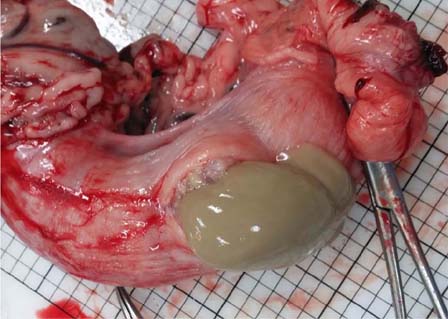Immune Netw.
2017 Apr;17(2):128-131. 10.4110/in.2017.17.2.128.
Sterile Pyometra in Two Dogs
- Affiliations
-
- 1Department of Veterinary Surgery, Konkuk University Veterinary Medical Teaching Hospital, Konkuk University, Seoul 05029, Korea.
- 2Department of Veterinary Internal Medicine, Konkuk University Veterinary Medical Teaching Hospital, Konkuk University, Seoul 05029, Korea. junghyun@konkuk.ac.kr
- KMID: 2376871
- DOI: http://doi.org/10.4110/in.2017.17.2.128
Abstract
- Two young dogs were referred to the Veterinary Medical Teaching Hospital of Konkuk University, one for examination of vaginal discharge and the other after being hit by a car. Dog 1 exhibited a high neutrophil count on Gram-stained vaginal smears, marked leukocytosis on a complete blood count, and uterine enlargement on ultrasonography. In dog 2, a markedly enlarged right uterine horn containing echogenic debris was found incidentally on ultrasonography. A tentative diagnosis of pyometra was made in both cases and ovariohysterectomy was performed. Purulent material was collected from each uterine horn and submitted separately for aerobic and anaerobic bacterial culture; all culture results were negative. The white blood cell count revealed normal limits 2 days post operation in dog 1 and 4 days post operation in dog 2. Positive bacterial cultures are usually obtained from dogs with pyometra, and antibiotic selection is based on the results of culture and sensitivity testing in the event of failure of empiric antibiotic therapy. However, in the cases reported here, no bacterial growth was identified from the uterine samples despite the presence of purulent material. A short course of empiric antibiotic therapy was administered. This is the first known report describing sterile pyometra in dogs.
MeSH Terms
Figure
Reference
-
1. Pretzer SD. Clinical presentation of canine pyometra and mucometra: a review. Theriogenology. 2008; 70:359–363.
Article2. Agostinho JM, de Souza A, Schocken-Iturrino RP, Beraldo LG, Borges CA, Avila FA, Marin JM. Escherichia coli strains isolated from the uteri horn, mouth, and rectum of bitches suffering from pyometra: virulence factors, antimicrobial susceptibilities, and clonal relationships among strains. Int J Microbiol. 2014; 2014:979584.3. Hagman R, Greko C. Antimicrobial resistance in Escherichia coli isolated from bitches with pyometra and from urine samples from other dogs. Vet Rec. 2005; 157:193–196.4. Harada K, Niina A, Nakai Y, Kataoka Y, Takahashi T. Prevalence of antimicrobial resistance in relation to virulence genes and phylogenetic origins among urogenital Escherichia coli isolates from dogs and cats in Japan. Am J Vet Res. 2012; 73:409–417.
Article5. Soleymani Majd H, Watermeyer S, Ismail L. Pyometra presenting in conjunction with bowel cancer in a post-menopausal women: a case report. Cases J. 2008; 1:24.
Article6. Contri A, Gloria A, Carluccio A, Pantaleo S, Robbe D. Effectiveness of a modified administration protocol for the medical treatment of canine pyometra. Vet Res Commun. 2015; 39:1–5.
Article7. Hagman R, Kindahl H, Lagerstedt AS. Pyometra in bitches induces elevated plasma endotoxin and prostaglandin F2alpha metabolite levels. Acta Vet Scand. 2006; 47:55–67.8. Enginler SO, Ates A, Diren Sıgırcı B, Sontas BH, Sonmez K, Karacam E, Ekici H, Evkuran Dal G, Gurel A. Measurement of C-reactive protein and prostaglandin F2alpha metabolite concentrations in differentiation of canine pyometra and cystic endometrial hyperplasia/mucometra. Reprod Domest Anim. 2014; 49:641–647.
Article9. Sundburg CR, Belanger JM, Bannasch DL, Famula TR, Oberbauer AM. Gonadectomy effects on the risk of immune disorders in the dog: a retrospective study. BMC Vet Res. 2016; 12:278.
Article10. Larsen B. Host defence mechanisms in obstetrics and gynaecology. Clin Obstet Gynaecol. 1983; 10:37–64.
Article11. Karlsson I, Hagman R, Johannisson A, Wang L, Sodersten F, Wernersson S. Multiplex cytokine analyses in dogs with pyometra suggest involvement of KC-like chemokine in canine bacterial sepsis. Vet Immunol Immunopathol. 2016; 170:41–46.
Article
- Full Text Links
- Actions
-
Cited
- CITED
-
- Close
- Share
- Similar articles
-
- Pneumoperitoneum Caused by the Spontaneous Perforation of a Pyometra in an 80-Year-Old Woman: A Case Report
- Spontaneous uterine perforation due to pyometra presenting as acute abdomen in older age
- Spontaneous Perforation of Pyometra Leading to Acute Abdomen
- Spontaneous rupture of pyometra : a case report
- A hermaphrodite dog with bilateral ovotestes and pyometra


